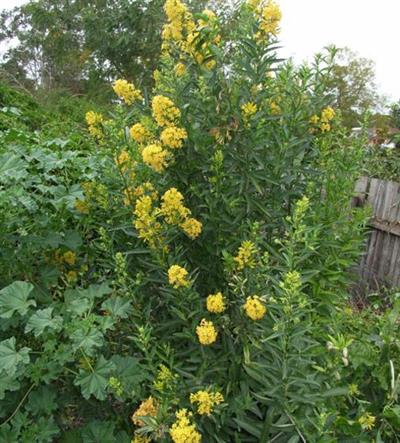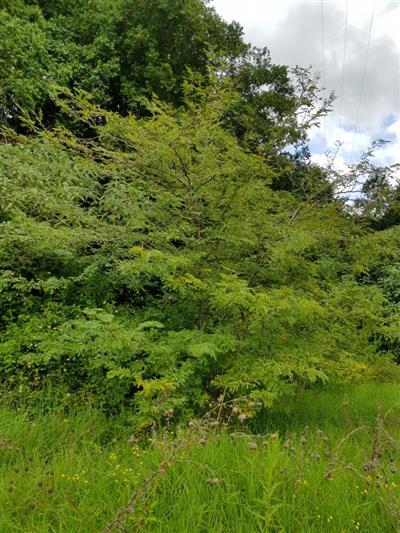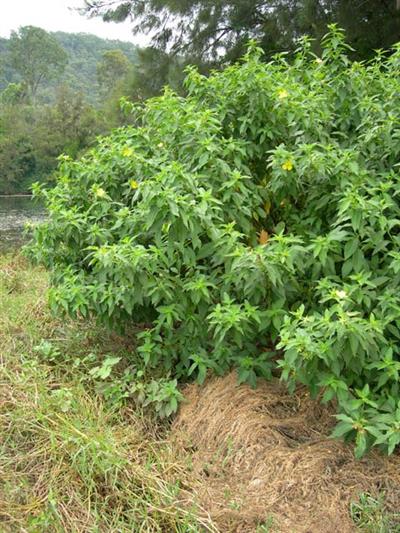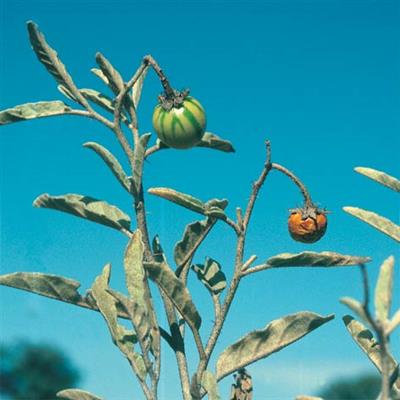 |
African boxthorn (Lycium ferocissimum)
African boxthorn is a very thorny scrub that grows up to 5 m high and 3 m across. Grown close together it forms a spiky wall that you cannot get through.
|
 |
Athel pine (Tamarix aphylla)
Athel pine is a spreading tree, up to 15 m tall. Immature trees have light grey stems, mature trees have a thick, rough, deeply furrowed bark and grey-brown stems. Strong woody roots spread deeply throughout the soil. Its minute, dull green leaves resemble pine tree ‘needles’ and are arranged along fine branchlets. Small flowers are pinkish-white without stalks, growing on 30–40 mm long spikes from the ends of the previous year’s branches. Its small bell-shaped capsules (2–3 mm long) contain many minute seeds that are topped with a tuft of tiny hairs.
Download fact sheet/weed management guide here.
|
 |
Blackberry (Rubus fruticosus species aggregate)
Blackberry or specifically, European blackberry (Rubus fruticosus species aggregate) is a collective name for different blackberry species; your local weed officer can help in identification. Plants in this group are characterized by a perennial shrub up to 2-3 metres tall with stems that grow up to 7m long. Stems (also called canes) are covered in sharp prickles and vary in colour (green, purplish or red) depending on how much sunlight it gets. Its leaves are arranged alternately along the stem in clusters of 3-5. Leaves are darker on the top-side and lighter on the underside, and is also covered by short, curved prickles. Its white or pink-coloured flowers are at the end of the canes and clustered like a cylinder or a pyramid. These develop into dark-coloured berries that contain about 20-30 seeds each. The roots of the Blackberry plant are woody and can penetrate deep into the ground (up to 4 metres).
Download fact sheet/weed management guide here.
|
 |
Blue heliotrope (Heliotropium amplexicaule)
Blue heliotrope is a hairy, low-growing perennial herb native to South America. Stems are highly branched and can grow to 15cm tall. Leaves are alternate, lance-shaped with wavy margins and can grow to 4cm long. Purple flowers have distinctly yellow bearded throats. Flowers are grown in clusters on one side of a curled stalk. Blue heliotrope flowers spring to early autumn.
Download fact sheet/weed management guide here.
|
 |
Bridal creeper (Asparagus asparagoides)
Bridal creeper is a smothering climber native to southern Africa. Its stems are wiry, branching and twining and can grow to 3m long. Leaves are flattened modified stems called cladodes and are oval with pointed tips. They are arranged alternately along branches with shiny green surfaces. Flowers are white, solitary and axillary with a prominent green stripe down each folded tepal (petal). Spring flowering. Fruit are globular berries that turn red at maturity.
Download fact sheet/weed management guide here.
|
 |
Burr ragweed (Ambrosia confertiflora)
Burr ragweed is a large, erect perennial herb that can grow to 2m tall. Leaves are alternately arranged and coarsely divided (bipinnate or more). Flowers are located on elongated spikes with male flowers above and female flowers in the leaf axes. Burr ragweed flowers are usually cream to greenish-yellow. Each plant produces numerous fruits that are covered in hooked spines that can easily attach to fur and clothing. Burr ragweed is summer flowering.
Download fact sheet/weed management guide here.
|
 |
Carrion flower (Orbea variegata)
Carrion flower is a leafless succulent that grows up to 25 cm tall. It has photosynthetic fleshy stems with serrated edges about 2 cm in width. It is grey-green in colour but has a tinge of purple when it is under full exposure to the sun. The flowers have five lobes shaped like a starfish and are cream to yellow in colour with brown or purple markings. As the name suggests, the flowers emit foul smelling odour. The flowers turn into a pair of smooth pods growing up to 12 cm long. Carrion flower prefers sandy well-drained soils and arid climates.
Download fact sheet/weed management guide here.
|
 |
Cats claw (Dolichandra unguis-cati)
Cat’s claw creeper is a rapidly climbing vine native to tropical dry forests of Central and South America. Leaves are opposite on the main stem usually in pairs (leaflets) with a tendril between the leaflets. Leaflets are dark green above and lighter below, usually 2-7cm long and 1-3cm wide. Tendrils three-pronged. Flowers are yellow, trumpet shaped with 5 fused petals. Oranges lines often present inside the floral tube. Spring flowering with flowers solitary or in clusters on the leaf axis. Seed pods ripen to a brown colour, 15-45cm long with a leathery feel. Each pod can contain 40-80 seeds which have two papery wings.
Download fact sheet/weed management guide here.
|
 |
Chilean needle grass (Nassella neesiana)
Chilean needle grass is a perennial tussock grass native to South America that can grow to 1m tall. It forms a deep, fibrous root system that can be difficult to remove. It has thin leaves around 30cm long with stiff hairs on the margins giving them a rough feel when touched. The long protrusions from the flowers (awns) are 60-90mm long, double bent and firmly attached to seed. The seeds sharply pointed and characteristically purple. Chilean needle grass can grow in a wide range or soil types and conditions, from fertile loams to degraded, nutrient-poor soils.
Download fact sheet/weed management guide here.
|
 |
Coolatai grass (Hyparrhenia hirta)
Coolatai grass is a summer growing perennial. It is widespread in northern NSW, in recent years has spread to southern areas.
Download fact sheet/weed management guide here.
|
 |
East Indian hygrophila (Hygrophila polysperma)
East Indian hygrophila is a marsh plant that can grow up to 1 m high. Its stems are rounded when underwater but square and slightly hairy above water. It has oblong-shaped leaves with pointed tips and similarly, are different above (rounder and stalkless) or below water (longer with small leaf stalks). Leaves can appear bright green, brown or reddish and can grow up to 8 cm long and 2 cm wide occurring as opposite pairs on the stem. Flowers are bluish-white to white in colour and found between the leaf and stem of the upper leaves. These transform into a narrow capsule about 6-7 mm long containing about 15-30 seeds. It can grow in waters up to 3 m deep and grows best in flowing water. It prefers growing in warm temperatures and neutral to slightly acidic water. As it can grow in low-light conditions, it can outcompete other aquatic plants.
Download fact sheet/weed management guide here.
|
 |
Fireweed (Senecio madagascariensis)
Fireweed is a branching annual or biennial herb which grows 10-60cm tall. It prefers growing on open areas like pastures and can grow in most soil types and in all aspect/direction. Fireweed has elongated leaves with a pointy tip and the margins of the leaf are serrated. The flowers of Fireweed are small, yellow, and can have up to 15 petals. Numerous seeds are produced by Fireweed which have white silky hairs that aid its spread through wind.
Download fact sheet/weed management guide here.
|
 |
Giant reed (Arundo donax)
Giant reed is a rhizomatous clump-forming perennial, native to Europe and Asia that can grow 6m tall and resembles (superficially) bamboo. Giant reed has many leaves, which are evenly spaced in two rows along the stem. Inflorescence (flowers) are large, up to 60cm long, erect and plume-like. The inflorescence is white when mature. Giant reed flowers in spring to summer. Frequently a weed of riverbanks and wetlands.
Download fact sheet/weed management guide here.
|
 |
Green cestrum (Cestrum parqui)
Green cestrum is a shrub that can grow up to 3m high. It has many brittle stems which are light green in colour. The leaves are lanceolate and about 8-10cm long and 1-3cm wide. Yellow flowers look like trumpets. The fruits of this plant appear like egg-shaped berries which change from green to black as it ripens. It commonly occurs near waterways and prefers loamy or clayey soils. It is frost tolerant and can grow in a wide range of soil types and rainfall. During winter, most of its leaves are shed but new growth occurs once spring sets in.
Download fact sheet/weed management guide here.
|
 |
Harrisia (Harrisia spp.)
Harrisia is a genus of cacti that form tangled mats up to 0.6 m high. Its stems are slender, branched, jointed every 30-45 cm and can grow up to 4-5 cm thick. Flowers are white and funnel-shaped with a green base, opening at night and withering the following morning. The fruits are red with white flesh and black seeds. There are three species present in the state: Harrisia martinii, H. tortuosa, and H. pomanensis and are differentiated mainly by their spines and fruits. H. martinii has a central spine 2-3.5 cm long surrounded by 1-3 spines 1.0-1.5 cm long as well as a row of spines. Fruits are warty with spines up to 5 mm long.
Download fact sheet/weed management guide here.
|
 |
Honey locust (Gleditsia triacanthos)
Honey locust is a deciduous, leguminous tree that can grow up to 25m tall. The leaves of this plant are compound and grow as 12 pairs of opposite leaflets, measuring approximately 20cm long. Spikes more than 10cm long are found on its trunk and limbs. Its yellow flowers are about 10 cm long and hang as clusters. These develop into brown pods up to 30cm long which have a sticky pulp that are attractive to livestock. Honey locust prefers alluvial flood plains although it can also survive extreme drought conditions.
Download fact sheet/weed management guide here.
|
 |
Hudson pear (Cylindropuntia pallida and Cylindropuntia tunicata)
C. pallida can grow up to 1.5 m high and up to 3 m wide. It has a cylindrical trunk and rope-like segments which can reach 90 cm long and 4cm wide. There are clusters of 4-8 spines on the stem which can reach up to 3.5 cm in length. C. tunicata grows only up to 0.6 meters high in comparison. Its segments are shorter and thinner, up to 20 cm long and 3 cm wide. However, its spines which are in groups of 4-7 are longer, reaching up to 7 cm long. These cacti can grow on most soil types but is mainly found on lighter soil types. Hudson pears can be found in a range of habitats including eucalypt woodlands, alluvial floodplains, shrublands and rocky outcrops.
Download fact sheet/weed management guide here.
|
 |
Hygrophila (Hygrophila costata)
Hygrophila is an aquatic weed growing up to 1.5 m high but branched at its lower parts. Its stems appear red to purplish and square in cross-section. The green leaves are veined and hairy, growing up to 18 cm long and 5 cm wide arranged as opposite pairs along the stems. The flowers are white or mauve in colour and are sparsely hairy developing into capsules 7-13 mm long containing up to 20 seeds.
Download fact sheet/weed management guide here.
|
 |
Johnson grass (Sorghum halepense)
Johnson grass is a tussock-forming perennial grass with a creeping, purple-spotted rhizome. It can grow to 2m tall with erect, upright stems. Leaves are hairless, 20 to 50cm long with a ligule where the sheath and leaf blade meet. Inflorescence is an open, purple spike with a shape that resembles a pyramid. Johnson grass is a summer flowering species. Johnson grass prefers wet areas such as irrigated farmland, waterways and drainage lines.
Download fact sheet/weed management guide here.
|
 |
Kidney-leaf mud plantain (Heteranthera reniformis)
Kidney-leaf mud plantain lives either as a submerged or floating aquatic weed that is able to grow up to 50 cm high. Its leaves are kidney shaped up to 5 cm wide and are arranged alternately along the stem. Young leaves are narrow but broaden as it matures. Flowers are white and occur on a spike with each spike containing up to nine flowers. Flowers develop into small capsules 1 mm long and containing 8-14 winged seeds.
Download fact sheet/weed management guide here.
|
 |
Long-leaf willow primrose (Ludwigia longifolia)
Long-leaf willow primrose is an erect, hairless annual with four-angled stems native to Brazil and Argentina. Leaves are linear and alternately arranged, growing from 10-20 cm long. Flowers are yellow, solitary and develop in leaf axils. Fruit is a capsule and is characteristically four-sided and oblong in shape. It is an aquatic weed that can aggressively invade areas of wetlands and waterways, forming dense colonies in still water.
Download fact sheet/weed management guide here.
|
 |
Mesquite (Prosopis spp.)
Mesquite are woody legumes which grow either as a single-stemmed tree reaching up to 15 m high or a multi-stemmed shrub reaching up to 5 m. Its branches have a characteristic zigzagging pattern. The bark appears smooth and dark red-green in young stems, turning rough and grey as it matures. The leaves are twice divided (bi-pinnate), occurring as 1-4 pairs of primary leaflets with 7-21 pairs of small opposite secondary leaflets. Up to two thorns are present at the base of the leaves. The greenish cream-yellow flowers of this plant appear cylindrical and grow to 80 mm in length. Fruit are legumes (pods) that grow to 20 cm long. Pods turn from green when young to yellow, purple, or yellow with purple streaks and patches when ripe.
Download fact sheet/weed management guide here.
|
 |
Mother-of-millions (Bryophyllum spp.)
Mother-of-millions (Bryophyllum delagoense) and hybrid of Mother-of-millions (Bryophyllum x houghtonii) are short-lived perennial succulent plants native to Madagascar. Mother-of-millions has upright stems that can grow to 30 – 180 cm tall. The stems are grey to pinkish, hairless and generally unbranched. The leaves are similar in colour to the stems but with darker mottling, which is occasionally also present on the stems. Leaves are fleshy and grow to 15 to 150 mm long and 2 – 6mm wide with teeth-like projections where plantlets form. Flowers are bell-shaped with the colour ranging from red to pink. It has four petals which are fused into a tube for most of their length. Flower form dense, drooping clusters at the top of stems.
Download fact sheet/weed management guide here.
|
 |
Peruvian primrose (Ludwigia peruviana)
Peruvian primrose is a shrub that can grow up to 3 m high. Branching stems of this plant are hairy when young and mature to dark green to brownish green. The leaves are arranged alternately along the stem and are sessile/stalkless. Leaves can grow 5-10 cm long and 1-3 cm wide and are oval shaped with a pointed tip. Flowers last a day and are bright yellow 2-4cm across, with 4 petals (sometimes 5-6), growing in fork of upper leaves. It has a reddish-brown capsule-type fruit containing numerous seeds.
Download fact sheet/weed management guide here.
|
 |
Prickly pears - Cylindropuntias (Cylindropuntia species)
Cylindropuntia species are part of the group of opuntioid cacti that are Weeds of National Significance in Australia, and a number of individual species are problematic in NSW.
They include Boxing glove cactus and Rope pear.
Download fact sheet/weed management guide here.
|
 |
Prickly pears (Opuntia species)
Weed type Cactus. Also known as: common prickly pear, prickly pear, common pest pear.
Download fact sheet/weed management guide here.
|
 |
Sagittaria (Sagittaria platyphylla)
Sagittaria is an aquatic weed in New South Wales, capable of aggressive growth and rapid spread. Also known as Arrowhead.
Download fact sheet/weed management guide here.
|
 |
Serrated tussock (Nassella trichotoma)
Serrated tussock is a tussock-forming perennial native to South America. It can grow to 60cm tall and 15cm wide with a deep and fibrous root system. Leaf blades are tightly rolled, thin and rough with small serrations. It has a characteristic ligule which is white, hairless, and around 1mm long. Seeds have relatively small, straight, or double bent awn firmly fixed to seed. Seed surrounded by dark purple glumes. Spring to summer flowering.
Download fact sheet/weed management guide here.
|
 |
Silver leaf nightshade (Solanum elaeagnifolium)
Silverleaf nightshade is an erect perennial herb p to 600mm tall native to North and South America. Stems have abundant reddish prickles. Leaves are hairy/woolly and silvery 2.5 to 10cm long. Flowers are in clusters (1-4), usually blue but can be white, pink or purple. Fruit are formed as berries which mature to orange-brown. Silverleaf nightshade flowers in late spring to summer.
Download fact sheet/weed management guide here.
|
 |
Spiny burr grass (Cenchrus longispinus)
Spiny burrgrass is an erect or spreading annual grass native to warm, dry areas of the northern hemisphere. It can grow to 60cm tall with prominent burrs. The burrs are the seed source of Spiny burrgrass. Burrs are typically oval with stout bristles that are densely hairy with a purple-tinged tip. The burrs bristles or spines are narrow and interlock.
Download fact sheet/weed management guide here.
|
 |
St. John's wort (Hypericum perforatum)
From November to January, St John’s wort can be identified by its vibrant yellow flower which is around 20mm in diameter. Each flower will have five petals and three stamens in the middle. St John’s wort has a 1m root system and will grow to 60cm in height. There are two types of St John’s wort; narrow leaf strain and broad leaf strain.
Download fact sheet/weed management guide here.
|
 |
Sweet Briar (Rosa rubiginosa)
Sweet briar is a thorny, perennial shrub that reduces the carrying capacity of land, harbour rabbits, restrict vehicle access and stock movement. It commonly grows 1.5 to 2m high but can be up to 3m. It has many thorny stems that arch towards the top and bears pink or white flowers and orange-red fruit.
|
 |
Yellow waterlily (Nymphaea mexicana)
Yellow waterlily has large floating leaves and bright yellow flowers. It forms dense infestations on waterways that reduce water quality and outcompete native plants.
Download fact sheet/weed management guide here.
|